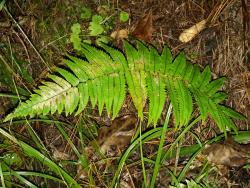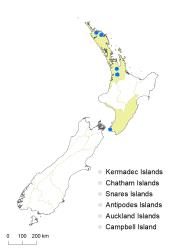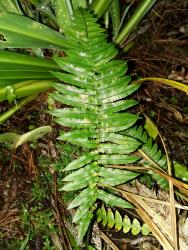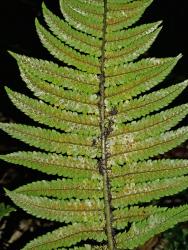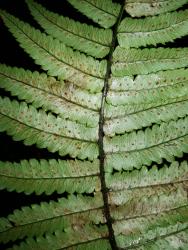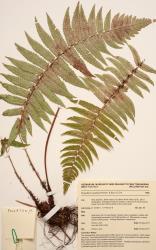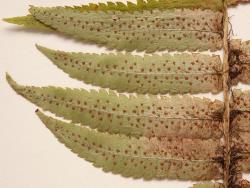- ≡ Aspidium cycadinum Franch. & Sav., Enum. Pl. Jap. 2, 236 (1879)
Rhizomes erect, densely scaly. Rhizome scales ovate to narrowly ovate, 12–17 mm long, 1.5–4 mm wide, blackish-brown, concolorous, margins ciliate. Fronds 340–800 mm long. Stipes 130–250 mm long, pale brown, abundantly scaly especially near junction with the rhizome; scales narrowly ovate, blackish-brown, ciliate, up to 15 mm long and 1.2 mm wide. Rachises pale or yellow-brown, sulcate, not winged, scaly; scales scattered throughout but more abundant at pinna junctions, linear, blackish-brown, up to 6 mm long and 0.4 mm wide. Laminae 1-pinnate at base, elliptic, 180–580 mm long, 80–200 mm wide, mid-green on both surfaces, herbaceous, bearing flat scales on abaxial costae, ± glabrous on adaxial surface. Primary pinnae in 17–30 pairs below pinnatifid terminal segment, slightly overlapping, narrowly ovate or narrowly elliptic; the longest at or near the middle, 44–115 mm long, 14–17 mm wide, apices acute or acuminate, margins deeply serrate, bases sessile or short-stalked; not dark at junctions with rachis when fresh. Sori present on all pinnae, round, in 1–2 rows either side of costa, nearer costa than margin; indusia reniform, flat when young, 0.4–0.6 mm diameter, concolorous, glabrous.
Dryopteris cycadina is recognised by its erect rhizome with narrowly ovate, blackish-brown, ciliate scales, 1‑pinnate laminae with deeply serrate pinnae, and sori in 1–2 rows either side of the costa.
North Island: Northland, Auckland, Southern North Island.
Altitudinal range: 10–80 m.
Collected in Kerikeri and Wellington from plants occurring spontaneously in gardens, and from naturalised plants around Hamilton and the Waikato River.
Occurs naturally in China, Japan and Taiwan (Wu et al. 2013).
Recorded growing under forest and scrub on river banks, beside a waterfall, and on a lake shore, as well as in urban habitats.
Heenan et al. (2004). Voucher AK 283998, 2003.



